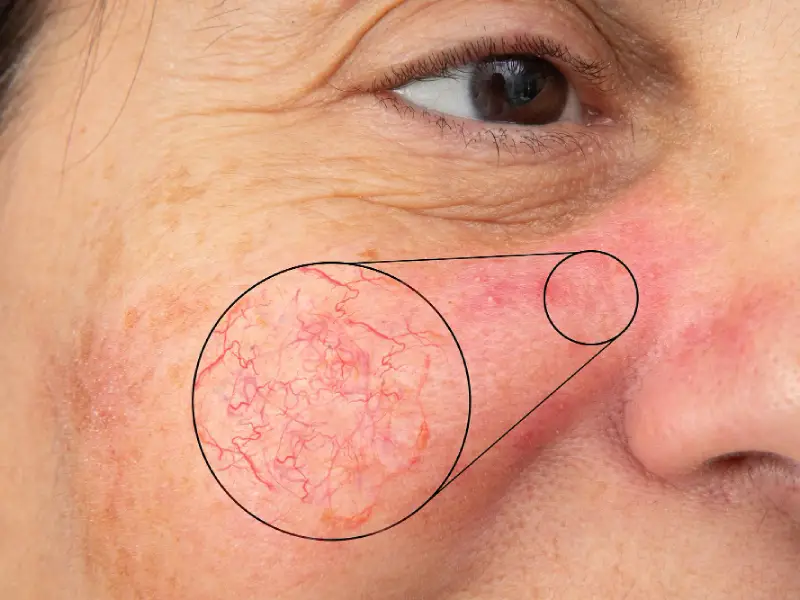Rosacea is a skin condition that affects millions of people around the world. Characterized by redness, visible blood vessels, and sometimes acne-like bumps, rosacea can be both physically and emotionally distressing. However, with the right rosacea skin care routine and products, managing this condition becomes more attainable. In this comprehensive guide, we will explore the best practices for rosacea skin care, including effective routines and recommended products that can help you achieve healthier, more radiant skin.
Understanding Rosacea
Before delving into rosacea skin care, it’s essential to understand the condition itself. Rosacea is a chronic skin disorder that primarily affects the face, often appearing as redness, flushing, and visible blood vessels (telangiectasia). In some cases, papules and pustules that resemble acne can also develop. Although the exact cause of rosacea remains unknown, several factors are known to trigger or exacerbate the condition, including:
- Genetics: Rosacea often runs in families, suggesting a genetic component, and having a family history of the condition may increase one’s risk of developing it.
- Environmental factors: Extreme temperatures, sun exposure, and wind can trigger or worsen symptoms, making it important for individuals with rosacea to protect their skin from these environmental stressors.
- Diet: Spicy foods, alcohol, and hot beverages are common triggers for rosacea, so individuals may find relief by avoiding these dietary factors known to exacerbate symptoms.
- Skin mites: Demodex mites living on the skin can contribute to rosacea symptoms in some individuals, highlighting the complex interplay between skin microorganisms and the condition’s development.
- Blood vessel abnormalities: Abnormalities in facial blood vessels may play a role in the development of rosacea, contributing to the characteristic redness and visible blood vessels seen in affected individuals.
Common Symptoms of Rosacea
Rosacea is a chronic skin condition characterized by various symptoms that can affect the facial skin and, in some cases, the eyes. Understanding these symptoms is crucial for effective management and treatment. Here, we’ll delve into the common manifestations of rosacea in greater detail:
- Persistent Facial Redness: One of the hallmark signs of rosacea is the presence of persistent facial redness. This redness often resembles a sunburn or a constant blush that doesn’t seem to fade away. It can be a source of discomfort and self-consciousness for individuals with rosacea.
- Visible Blood Vessels (Telangiectasia): Another common symptom is the appearance of small, visible blood vessels in the affected areas, especially on the cheeks and nose. These tiny, red or purple lines, known as telangiectasia, can contribute to the overall redness and give the skin a flushed appearance

- Bumps and Pimples: Rosacea can manifest as small, red bumps and pimples on the face. These can be easily confused with acne, leading to potential misdiagnosis and inappropriate treatments. These bumps are often referred to as papules and pustules and can cause further skin irritation and sensitivity.
- Eye Irritation (Ocular Rosacea): In some cases, rosacea can extend beyond the skin and affect the eyes, leading to a condition known as ocular rosacea. This can result in a range of eye-related symptoms, including redness, burning sensations, dryness, and increased sensitivity to light. Ocular rosacea can be particularly bothersome and may require specialized care.
A deeper understanding of these common rosacea symptoms is essential for individuals dealing with this condition. With this comprehensive knowledge of rosacea symptoms in mind, let’s now explore how implementing a well-structured rosacea skincare routine can play a pivotal role in managing and alleviating these challenging symptoms.
Rosacea Skin Care Routine
In this section, we’ll outline a comprehensive rosacea skin care routine designed to alleviate symptoms and maintain skin health. By following these steps and understanding their significance, individuals with rosacea can work towards achieving a more comfortable and confident complexion.
- Gentle Cleansing: The foundation of any rosacea skin care routine is a gentle cleanser. Avoid harsh soaps or abrasive scrubs, as they can exacerbate redness and irritation. Opt for a mild, hydrating cleanser that is free from fragrances and harsh chemicals.
- Sun Protection: Sun exposure is a significant trigger for rosacea flare-ups. Use a broad-spectrum sunscreen with an SPF of 30 or higher at all times. Look for sunscreens that contain zinc oxide or titanium dioxide, as these ingredients are less likely to irritate sensitive skin.
- Moisturize: Moisturizing is crucial for rosacea-prone skin. Choose a fragrance-free, hypoallergenic moisturizer that helps lock in moisture without clogging pores. Apply it morning and night to maintain skin hydration.

- Avoid Irritating Ingredients: When selecting skincare products, check the ingredient labels for common irritants like alcohol, menthol, eucalyptus, and witch hazel. These can worsen redness and should be avoided.
- Anti-Inflammatory Products: Look for products containing ingredients known for their anti-inflammatory properties, such as niacinamide and ceramides. These can help calm and soothe redness and irritation associated with rosacea.
- Prescription Creams: Sometimes, a dermatologist may prescribe topical medications like metronidazole or azelaic acid creams to manage rosacea symptoms. These can be integrated into your skincare routine under the guidance of a healthcare professional.
- Avoid Hot Water: Hot water can be harsh on rosacea-prone skin. When washing your face or showering, use lukewarm water to prevent exacerbating redness and irritation.
Best Products for Rosacea Skin Care
Now that we’ve discussed the essential components of a rosacea skin care routine, let’s explore some recommended products specifically designed for this skin condition. Investing in the right skincare products can make a significant difference in managing rosacea. Here are some recommended products:
- Rosacea Cream: Look for creams containing ingredients like azelaic acid, which can reduce redness and inflammation.
- Serums with Niacinamide: Niacinamide has anti-inflammatory properties and can help control redness and breakouts.
- Gentle Exfoliants: Opt for chemical exfoliants with mild ingredients like lactic acid or polyhydroxy acids, as they can help remove dead skin cells without causing irritation.
- Sulfur Masks: Sulfur masks can be used occasionally to reduce redness and manage breakouts.
Online Rosacea Treatment
In addition to topical treatments and skincare products, many individuals with rosacea find online resources and support groups to be invaluable. Online rosacea treatment platforms can provide information, tips, and emotional support for those managing this condition. However, it’s important to consult with a healthcare professional for personalized treatment recommendations, especially if your rosacea is severe or not responding to over-the-counter products.

Final Thoughts
In the pursuit of mastering the art of rosacea skincare, it’s crucial to remember that living with rosacea is not a solitary journey. Millions of individuals worldwide are dealing with this condition, and they share both the challenges and triumphs that come with it. Understanding rosacea’s multifaceted nature, including its genetic predisposition and the influence of environmental factors, helps us comprehend the complexity of this condition. While there’s no one-size-fits-all solution, the right skincare routine and product selection, coupled with lifestyle adjustments, can significantly improve the quality of life for those managing rosacea.
In closing, embracing a holistic approach to rosacea management that combines effective skincare practices, awareness of potential triggers, and the support of healthcare professionals and online communities can empower individuals to regain control over their skin’s health. Remember that managing rosacea is not just about minimizing its physical manifestations; it’s also about boosting self-confidence and embracing a more comfortable, radiant, and vibrant you. So, with patience, diligence, and the right information at your fingertips, you can say goodbye to redness and confidently master the art of rosacea skincare.
FAQs
- Is rosacea contagious?
No, rosacea is not contagious; it’s a non-infectious skin condition.
- How can I reduce facial redness from rosacea?
A gentle skincare routine, sunscreen, and avoiding triggers like hot showers can help reduce facial redness.
- What skincare products should I avoid with rosacea?
Avoid products with harsh ingredients like alcohol, menthol, and fragrances, as they can worsen rosacea symptoms.
- Are there natural remedies for rosacea?
Some natural remedies like green tea extract and liquorice root have anti-inflammatory properties and may offer relief.
